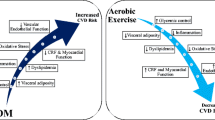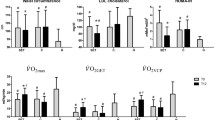Summary
INTRODUCTION: Levels of the endogenous nitric oxide synthase inhibitor asymmetrical dimethylarginine (ADMA) are elevated in patients with type 1 diabetes mellitus (DM1) and may contribute to vascular complications. In this study we tested the hypothesis that elevated ADMA in patients with DM1 can be reduced by regular physical exercise. METHODS: Plasma samples for analysis of L-arginine, ADMA, symmetrical dimethylarginine (SDMA) and metabolic parameters were obtained from 11 patients with DM1 who participated in a supervised aerobic exercise program for four months. Samples were collected before the training began, at two and four months after initiation, and eight months after cessation of regular training. Fifteen age- and sex-matched healthy persons who did not exercise regularly were examined once as controls and did not participate in the training program. RESULTS: The patients with DM1 had higher ADMA levels than the controls before the training program began (0.54 ± 0.02 vs. 0.44 ± 0.03 μmol/l; P < 0.05). After two and four months of exercise, ADMA concentrations in the patients decreased to those seen in healthy persons (0.42 ± 0.02 and 0.43 ± 0.03 μmol/l; P < 0.001 and P < 0.05 compared with ADMA levels before training began). Eight months after cessation of the exercise program, ADMA levels in the patients reverted to those observed before the start of training. The L-arginine-to-ADMA ratio increased slightly after two months; L-arginine, symmetrical dimethylarginine, blood lipids and HbA1c were not affected by the training program. CONCLUSIONS: Elevated ADMA levels in patients with DM1, who have a high risk for developing cardiovascular disease, can be lowered to those of healthy persons by regular physical exercise. This favorable effect on ADMA is not sustained when training is discontinued.
Zusammenfassung
EINLEITUNG: Patienten mit Diabetes mellitus Typ 1 (DM1) haben erhöhte Plasmakonzentrationen des endogenen Stickstoffmonoxid-Synthase-Inhibitors asymmetrisches Dimethylarginin (ADMA). Erhöhtes ADMA könnte zu den vaskulären Komplikationen, die bei diesen Patienten beobachtet werden, beitragen. In unserer Studie untersuchten wir die Hypothese, dass ADMA bei Patienten mit DM1 durch körperliches Training reduziert werden kann. METHODEN: Plasmaproben von 11 Patienten mit DM1, welche an einem beaufsichtigten aeroben Trainingsprogramm für 4 Monate teilnahmen, wurden vor und 2 und 4 Monate nach Beginn sowie 8 Monate nach Beendigung des regelmäßigen Trainings zur Analyse von L-Arginin, ADMA und symmetrischem Dimethylarginin (SDMA) gewonnen. Fünfzehn Alters- und Geschlechts-angepasste gesunde Freiwillige, welche kein regelmäßiges Training durchführten, dienten als Kontrollgruppe. ERGEBNISSE: Vor Beginn des Trainings hatten Patienten mit DM1 höheres Plasma-ADMA als die Kontrollpersonen (0,54 ± 0,02 vs. 0,44 ± 0,03 μmol/l; p < 0,05). Nach 2 und 4 Monaten Training nahmen die ADMA-Konzentrationen auf Werte, welche mit denen der gesunden Kontrollgruppe vergleichbar waren, ab (0,42 ± 0,02 und 0,43 ± 0,03 μmol/l; P < 0,001 und P < 0,05 im Vergleich zu Konzentrationen vor Beginn des Trainings). Acht Monate nach Beendigung des Trainingsprogramms waren die ADMA-Konzentrationen wieder mit jenen vor dem Training vergleichbar. Die L-Arginin/ADMA-Ratio nahm nach 2 Monaten gering zu. L-Arginin, SDMA, Blutfette und HbA1c wurden durch das Trainingsprogramm nicht beeinflusst. KONKLUSION: Bei Patienten mit DM1, welche ein hohes Risiko für kardiovaskuläre Erkrankungen haben, kann erhöhtes ADMA durch regelmäßiges körperliches Training auf Werte von gesunden Personen reduziert werden. Dieser günstige Effekt auf ADMA hält nicht an, wenn das regelmäßige Training unterbrochen wird.
Similar content being viewed by others
Author information
Authors and Affiliations
Corresponding author
Rights and permissions
About this article
Cite this article
Mittermayer, F., Pleiner, J., Krzyzanowska, K. et al. Regular physical exercise normalizes elevated asymmetrical dimethylarginine concentrations in patients with type 1 diabetes mellitus. Wien Klin Wochenschr 117, 816–820 (2005). https://doi.org/10.1007/s00508-005-0476-y
Received:
Accepted:
Issue Date:
DOI: https://doi.org/10.1007/s00508-005-0476-y




